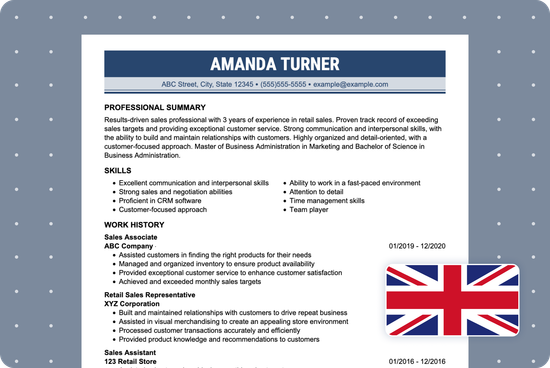UK Resume Format: Best Practices & Examples

Our customers have been hired at: *Foot Note
According to Tony Wilson, director at the Institute for Employment Studies, the UK has seen a sharp rise in unemployment in 2024. Indeed, redundancies are rising, inflation remains high, and the unemployment rate is expected to be at 4.4% and remain there through 2025.
As the labor market in the UK has grown cooler, competition between job seekers has intensified. You need the proper tools to get ahead in today’s job market, and we’re here to equip you with the best UK resume format.
In this guide, we show you how to write an impressive UK resume, provide professional UK resume examples, and offer tips for perfecting your resume.
UK resume examples for top jobs
How to choose a UK resume format
The UK resume is similar to the US resume, except the UK resume allows for more pages and information. And while the US resume is often written in one of three resume formats, a UK resume typically relies on two formats: skills-based and reverse-chronological. Here’s how to choose the best resume format for a UK job application.
Reverse-chronological resume
The reverse-chronological resume format, also known as the chronological resume format, is the most widely used UK resume format and one that recruiters and hiring managers recognize as standard. Why? Because it’s easy for ATS programs and employers to scan.
This resume format emphasizes your work history, so it’s the better option if you have at least one year of professional experience and want to display your work accomplishments.
Skills-based resume
This UK resume format focuses on your job-relevant skills. Create categories and under them For example, if you are a chef, you might add culinary arts to your skill set and then describe the various culinary arts skills you have mastered, such as food preparation, cleanliness, knife skills, butchery, sauteeing and sauces.
Choose this resume format if you are applying for your first job, changing your career or have been out of work for a long time.
Ready to write your resume? Start with one of our professionally designed resume templates. Our ATS-friendly templates have been designed to present your job qualifications clearly and professionally — with style.
What to include in a UK resume
Header
Show off your professionalism right from the get-go with an eye-catching header. Include your name, phone number, email address and professional website, portfolio, or networking profile if you have them.
Professional statement
Your professional statementis your chance to introduce yourself to potential employers. In three to five sentences, tell them who you are and why you’re the best person for the job. Use keywords from the job description to grab the hiring manager’s attention, paying close attention to your job-relevant skills.
For example:
“Passionate educator with six years of dedicated teaching experience across various grade levels. Proven track record of fostering a positive and inclusive learning environment that engages students and enhances their academic growth. Proficient in curriculum development, lesson planning, and implementing innovative teaching strategies to meet diverse learning styles. Dedicated to inspiring a love for learning and empowering students to reach their full potential academically, socially, and emotionally.”
Work history
If you are using the chronological UK resume format, hiring managers will scour your employment history for details about what you’ve done over the course of your
career. Highlight your achievements — not your responsibilities — to stand out.
To display your work experience, add the employers you worked for, their location and the dates you worked for them. Under each role, add three bullet points with your quantifiable achievements.
In three to five bullet points, describe your accomplishments for each job, tailoring them to the job description. Combine your work accomplishments with action verbs for impact.
For example:
Registered Nurse, Premier Hospital, Anytown, U.K. January 2018 - Present
- Implemented evidence-based nursing interventions resulting in a 20% reduction in patient readmission rates within the surgical unit.
- Led a multidisciplinary team in developing and implementing a new protocol for post-operative pain management, resulting in a 30% decrease in opioid use among patients while maintaining high levels of pain control.
- Conducted patient education sessions on wound care and infection prevention, which resulted in a 25% decrease in post-operative wound infections.
- Achieved a 95% patient satisfaction rating through attentive care, clear communication, and compassionate bedside manner.
- Collaborated with physicians and allied health professionals to streamline patient care processes, reducing average patient discharge time by 15%.
Skills
Hiring managers and recruiters seek job candidates with a mix of hard and soft skills for their industry.
Hard skills show potential employers that you have the knowledge it takes to perform the essential functions of the job. They are specific to a role and include aptitudes such as data analysis, spreadsheets and writing.
Soft skills tell employers that you have the personality traits and qualities to help you stand out from others with similar technical aptitude. Examples include verbal communication, active listening and adaptability.
Top hard skills
| Top soft skills
|
Education
Education is vital for a UK resume, no matter how long you’ve worked. On the chronological UK resume format, place your education section under your skills section. To list your education credentials, start with your highest level of education and work backward if you’ve received more than a degree. Add the school’s name, location and graduation date. Include a bullet list of relevant coursework and awards or honors you received at each institution.
For example:
Bachelor of Science in Computer Science
University Name, City, State
Graduated: May 20XX
Relevant Coursework:
- Data Structures and Algorithms
- Object-Oriented Programming
- Software Engineering Principles
Awards
- Deans List
- Programming Completion Award of Excellence
If you’re still completing your education, include it and add “In progress” or the date you expect to complete your studies. Include a bullet list of job-relevant courses you have taken.
Optional sections
Adding optional sections to your UK resume can help you shine. Since it’s acceptable to use a two-page UK resume format, consider adding one or more of the following bonus sections to your resume if you have room:
- Volunteer work demonstrates your passion, values and commitment, highlights your transferable skills, and fills gaps in your employment.
- Awards distinguish you as an exceptional job candidate, indicate work ethic, and highlight job-relevant strengths and achievements.
- Professional memberships indicate your commitment to your industry and professional development and add credibility to your UK resume.
- Hobbies provide a glimpse into your personality, show you’re well-rounded and make you a more interesting job candidate.
- Publications and presentations indicate expertise in your field, set you apart from other job candidates, and enhance your credibility.
Make a resume with MyPerfectResume
Our Resume builder can help you write the perfect resume. Start Now!
Modify your US resume for a UK job
If you already have a US resume, you don’t have to start a new resume from scratch to apply for a job in the United Kingdom.
- Try UK NARIC (National Recognition Information Centre for the United Kingdom) to find the UK equivalents for your US educational and professional credentials.
- Re-craft your resume to align with a UK resume format. Shorten your US resume to two pages, keeping the critical elements intact and tailoring them to match the job you seek.
- Localize your resume. Use business and industry terminology typical for the United Kingdom and UK units of measure, spelling and grammar conventions.
Modify your UK resume format for the US job market
If you are in the United Kingdom and applying for work in the United States, follow these tips to adapt your UK resume to match the US equivalent and increase your chances of getting your dream job.
- Use a credential evaluation service, like the National Association of Credential Evaluation Services (NACES) to find the UK equivalents for your US educational and professional qualifications.
- Use US terminology, spelling and grammar in your resume. For example, use "ZIP code" instead of "postcode,” “program” instead of “programme,” and month-day-year for the date.
- Include your work authorization status. If you require work authorization to work in the US, include your work authorization status in your resume so employers know you are eligible to work there.
Tips to write an effective UK resume
- Choose a UK resume format that fits your career stage.
- Use a resume template to ensure your UK resume is formatted correctly and easily read.
- Customize your resume for every job you apply to.
- Include resume keywords throughout your resume to ensure it’s ATS-friendly and catches the hiring manager's attention.
- Avoid graphics and personal information such as your age and home address.
- Proofread your UK resume. Use spell-checkers, online tools and another pair of trusted eyes.
- Include a cover letter to complement your UK resume.
Key takeaways
- A UK resume is similar to the US resume, except the UK resume allows for more pages and information
- The first step to creating an impressive UK resume is choosing the right UK resume format for your career stage.
- Tailor your UK resume to the job description to emphasize your qualifications.
- Spotlight your measurable achievements instead of your job duties.
- Ensure your UK resume is ATS-friendly by using keywords from the job description and formatting your resume correctly.
Resources for your UK resume format
FAQ
How can I navigate the UK job market as a foreigner?
Navigating the UK job market as a foreigner can be challenging, but with the right approach and preparation, you can increase your chances of success.
Here are some steps you can take:
- Understand visa requirements: Ensure you understand the visa requirements for UK work. Depending on your nationality and circumstances, you may need a work visa or other permits to work in the country legally. Visit the UK government’s website or consult an immigration advisor for the most up-to-date information.
- Research the job market: Familiarize yourself with the UK job market by researching industries, companies and job opportunities. Identify sectors that are in demand and align with your skills, qualifications and experience.
- Tailor your CV and cover letter: Adapt your CV/resume and cover letter to the UK format and standards. Highlight relevant experience, skills and qualifications that are sought after in the UK job market. Customize your application for each position you apply for, emphasizing how your background makes you a good fit for the role.
- Utilize online job portals: Search for job vacancies in the UK using online job portals and professional networking sites such as LinkedIn, Indeed, Reed, and Totaljobs. Create a strong online profile and actively network with professionals in your industry.
- Consider recruitment agencies: Recruitment agencies can help match you with suitable job opportunities. Research reputable agencies that specialize in your field and register with them to access their job listings and services.
How do I address gaps in my employment on a UK CV?
Addressing gaps in your employment history on a UK CV requires transparency and strategic communication. Here are five ways to effectively handle employment gaps:
- Be honest: Always be truthful about the reasons for any gaps in your employment history. Attempting to conceal or misrepresent the gaps may raise red flags during recruitment.
- Provide a brief explanation: Include a concise explanation for the gap in your CV. Whether it was due to personal reasons, further education, traveling, or career transition, briefly mention the reason for the gap without going into excessive detail.
- Highlight relevant activities: If you were engaged in any activities during the gap period relevant to the job you’re applying for, such as freelancing, volunteering, or taking courses, be sure to include them on your CV. Highlighting these activities demonstrates that you remained productive and proactive during your gap period.
- Focus on your skills and achievements: Emphasize transferable skills, experiences or achievements gained during the gap period relevant to the position you’re applying for. This could include developing new skills, undertaking projects or acquiring certifications.
- Use a skills-based UK CV format: If your traditional chronological UK CV format emphasizes the gap too prominently, consider using a skills-based format. This format focuses more on your skills and accomplishments than your chronological work history, allowing you to downplay employment gaps.
- Address employment gaps in your cover letter: If you feel your CV doesn’t adequately explain the employment gap, you can address it briefly in your cover letter. Use the cover letter to provide context and reassure the employer of your commitment and suitability for the role.
What sections should be included in a UK CV?
The standard UK CV format usually has two pages. However, for professionals with extensive experience, such as academics or senior executives, a CV may extend to three or even four pages.
A UK CV format typically includes the following sections:
- Personal details: Name, contact information and professional profiles.
- A professional statement: Summarize who you are and what you offer.
- Work experience: List previous employment, including job titles, dates and brief descriptions of responsibilities and achievements.
- Education: Add details of academic qualifications, including degrees, certifications and any relevant training.
- Skills: Highlight job-relevant skills and competencies.
- Additional sections: Optional sections include hobbies and interests, professional memberships, languages or volunteer experience.
What is the preferred layout and design for a UK CV format?
A UK CV should have a clean and professional layout, with clear headings and bullet points for easy readability. Use a legible font such as Arial or Times New Roman, with 10-12 points font size. Avoid using decorative fonts or excessive graphics, and maintain consistent formatting throughout the document.
Should I include a photo on my UK CV?
We advise that you do not include a photo on a UK CV unless specifically requested by the employer or if you’re applying for a role where appearance is relevant, such as modeling or acting. Including a photo may introduce bias and is not recommended unless explicitly required.
How we reviewed this article
Since 2012, we have helped more than 11 million job seekers. We want to make your career journey accessible and manageable through our services and Career Center’s how-to guides and tips. In our commitment to bring you a transparent process, we present our Editorial Process.
Sources
- Expatica. Article. No Author. Applying for jobs in the UK: CV and interview tips
- LinkedIn. Article. Oluwaseun, 'Gabby' A. How to Write a UK CV Format
- The Guardian. Article Elliott, Larry. UK’s weak economy is taking a toll on its labour market
- The Guardian. Article. No Author. UK unemployment rate leaps to 4.2% amid fears of job cuts
- SHRM. Article. Stack, Chris. Crossing the Atlantic: A Comparison of US and UK Employment Concepts.
Our customers have been hired at:*Foot Note


